Botanical Names
Morinda citrifolia Linn.
Common Names
| Malaysia | Mengkudu besar, mengkudu jantan. |
| English | Indian mulberry, noni, Indian mulberry, painkiller, morinda. |
| Indonesia | Pace (Javanese), cangkudu (Sundanese), mengkudu (Malay). |
| Thailand | Yo baan, mataa-suea, yae-yai. |
| Philippines | Bankoro, tumbong-aso (tagalog), apatot (Ilokano). |
| Cambodia | Nhoër srôk, nhoër thôm’. |
| Laos | Nhoo baanz. |
| Vietnam | Nh[af]u l[os] chanh, ngao, nh[af]u n[us]i. |
Family
Rubiaceae
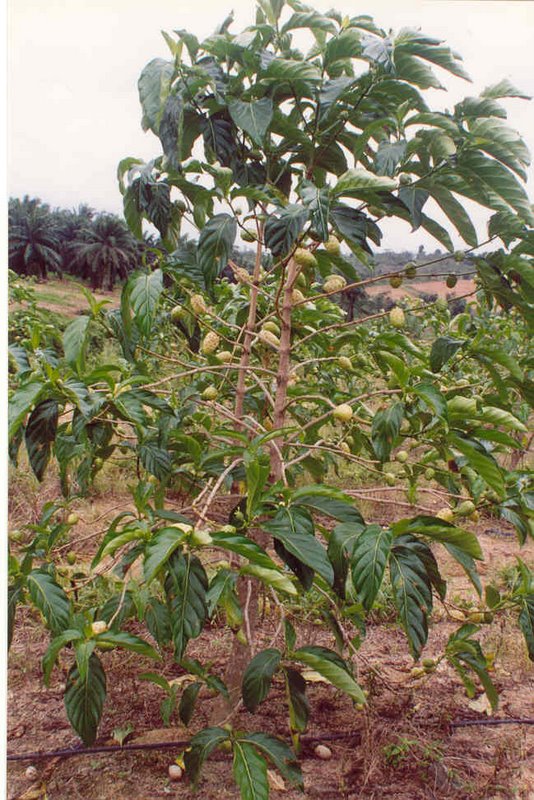
Introduction
‘Mengkudu’ is a perennial plant native of Asia, Australia and other islands of the Pacific. The plant can now be found throughout the world including Malaysia. In Malaysia, it is growing wild on the jungle outskirts especially on the river banks and drainage outlets.[1]
Morphological Features
‘Mengkudu’ is a small evergreen tree with vertical stems, broad leaves, white flowers and conical to oblong-shaped fruits. The young fruits are green but turn yellowish-white upon maturity. Ripe fruits are fleshy soft and with a strong foul smell. ‘Mengkudu’ tree can grow up to 10 m tall. There are two commonly found species in this country namely Morinda citrifolia (big fruits) and Morinda elliptica (small fruits).[1]
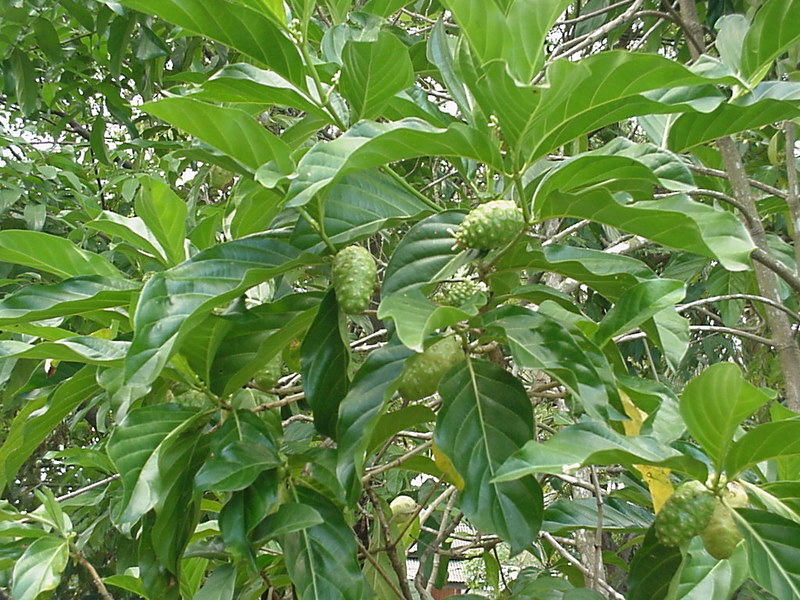
Medicinal Properties and Usage
In many parts of the world, ‘mengkudu’ is treated as a plant of important medicinal values. In Malaysia, it has been used for many generations as a traditional medicine particularly among the Malays. Until now, a vegetable dish made of cooked young leaves is still a popular health food. Globally, it has been reported that its juice is good for health especially in managing cancer, diabetes, hypertension, bone, heart, depression, respiratory, digestive and kidney problems.[1][2][3][4][5]
Soil Suitability and Climatic Requirement
‘Mengkudu’ is a hardy and easy growing plant. It grows well on most soils including marginal soils such as bris and peat. It can be planted in coastal areas up to 400 m above sea level. Areas with annual rainfall of 2,000-3,000 mm are ideal for good crop growth and yield. However, ‘mengkudu’ plant is susceptible to root knot nematode. Thus, areas with high nematode population such as bris sandy soil should be avoided.[1]
Field Preparation
Land Preparation
Prior to planting, normal field operations such as land clearing, disc ploughing and rotovation are to be conducted. Ground Magnesium Limestone (GML) and Triple Super Phosphate (TSP) each at the rate of 100 g per planting hole are applied for liming and basal fertilisation purposes respectively. The size of a planting hole is 30 cm x 30 cm x 30 cm. Field drainage system should also be established in areas where waterlogged is a threat.[1]
Production of Planting Materials
‘Mengkudu’ is propagated by seeds as the seeds can easily be collected from mature fruits. A medium size fruit can produce 200-250 seeds. Seeds are sown in sowing trays and then the seedlings should be transferred into 13 cm x 18 cm polybags. The seedlings are ready for field planting at 6 or 7-leaf stage or after 7 months in the polybags. It can also be propagated using seedlings raised from young stem cuttings.[1]
Field Planting
The recommended field planting distance is 5 m (between rows) x 3 m (within a row). This will give the population density of 667 plants/ha. The planting should be done at the beginning of the rainy season.[1]
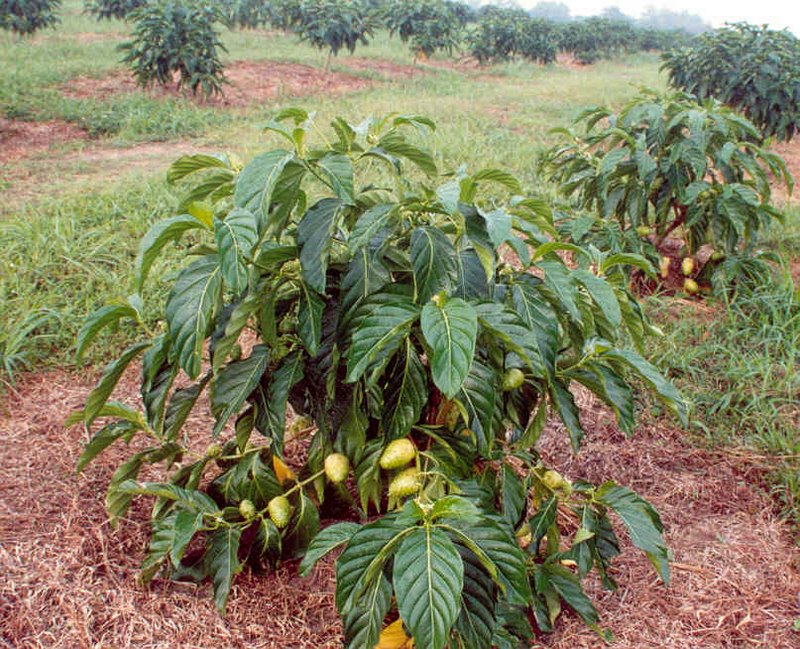
Field Maintenance
Fertilisation
Fertilisation is done using compound fertiliser NPK (12:12:17:2), processed chicken manure and GML (Ground Magnesium Limestone). Chicken manure is applied in the first year only at the rate of 1.0 kg/plant. Half of the rate is given at planting while the other half 6 months later. Compound fertiliser NPK is applied at the rate of 500, 750 and 1,000 g/plant in the 1st, 2nd and 3rd year upward, respectively. For each rate, the NPK fertiliser is divided into four equal parts and applied at 3 months intervals. GML at the rate of 300, 400 and 500 g/plant is applied in the 1st, 2nd and 3rd year upward, respectively.[1]
Weed Control
For the first five months after planting, weeds are controlled by two rounds of rotor-tillage operation. After that it can be done by spraying systemic or contact herbicides.[1]
Water Management
Supplementary irrigation is required for optimum crop growth and yield. Drip irrigation system is recommended for this crop.[1]
Pest and Disease Control
The most important pest for this crop is root knot nematode (Meloidogyne incognita). The symptoms of infected plants are yellowing, stunted growth, and plants eventually die due to root damages. The nematode is controlled by using sterilised growing media at the nursery stage and using nematicide e.g. Nemacur at the early growth stage in the field. Nonetheless, planting ‘mengkudu’ on soils with high population of nematode should be avoided.[1]
Harvesting
‘Mengkudu’ plant starts producing yield 6 months after planting. It bears fruit throughout the year. Mature fruits are harvested at 20-25 days intervals. The average fresh fruit yields obtained by a commercial farm are 1.2, 16.0 and 18.0 t/ha for the 1st, 2nd and 3rd year respectively. After that the crop yield presumably becomes stable and can last for at least 10 years.[1]
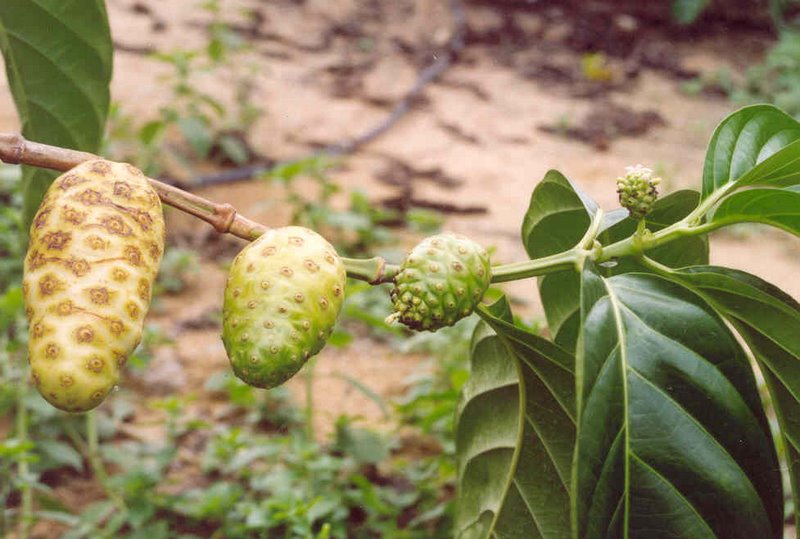
Postharvest Handling
Harvesting has to be done carefully to avoid fruit injury and contamination. The harvested fruits should immediately be transported to collection centre for cleaning, grading, storing and processing activities.[1]
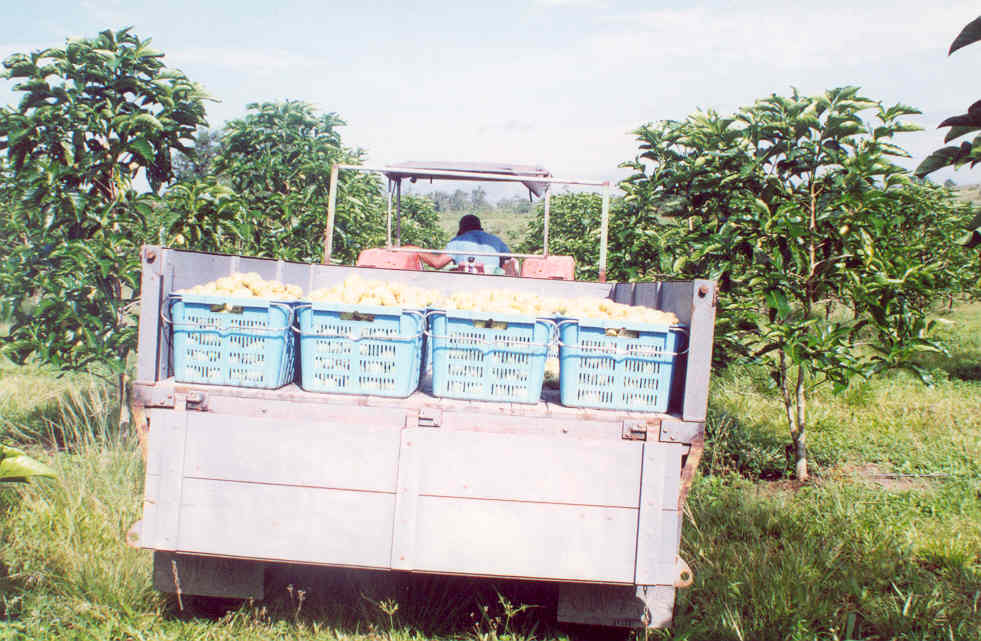
Estimated Cost Of Production
The total production cost for a 10-year production period is estimated at RM42,500/ha. Thus, for a total yield of 161.0 t/ha, the average cost of production of fresh fruit is RM0.30/kg. The production cost was estimated based on the cost of current inputs during writing of this article.[1]
Read More
References
- Muhamad Ghawas, M. 2005. Mengkudu (Morinda citrifolia Linn.). In: Penanaman tumbuhan ubatan & beraroma. (Musa, Y., Muhammad Ghawas, M. and Mansor, P., ed.). Pg. 124-129, Serdang: MARDI
- Muhamad Ghawas, M., Wan Zaki, W.M. and Mohamad Najib, M.Y. 2007. Penanaman mengkudu secara komersial– Pengesyoran dan prestasi awal. Buletin Teknol. Tanaman MARDI. 4:23-30.
- Anon. 2002. Compendium of Medicinal Plants Used in Malaysia (Vol. 2) Pg 149, Kuala Lumpur : HMRC-IMR
- Musa, Y. Azimah, K. and Zaharah, H. 2009. Tumbuhan Ubatan Popular Malaysia. Pg 188, Serdang : MARDI
- Indu Bala, J. and Ng, L.T. (2002). Herbs–The green pharmacy of Malaysia. Kuala Lumpur: Vinpress Sdn. Bhd. and MARDI, pp 63-65.


